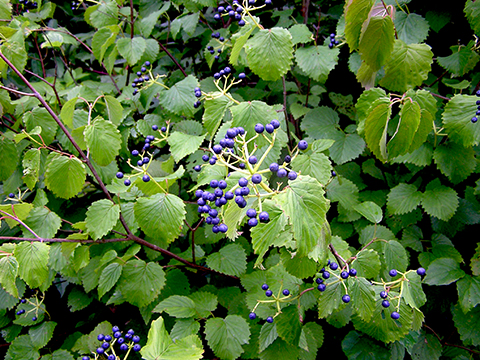 |
| Home | Ordering By Mail | Purchase Manual: Using Native Plants in Urban Landscapes |
|
|||||
Species Name: Viburnum dentatum
Common Name: Arrowwood viburnum
Zone: 3 to 8
Distribution: native from Maine south to Florida west to Illinois.
Seed collection: Arrowwood viburnum (AV) fruit matures in late August to early September in the northeast. Fruit gradually changes from green to bright blue or navy blue color when ripe. The fruits are a favorite of many songbirds as they are high in fats, are abundant and the right size for swallowing by tiny song birds. AV fruit is readily consumed especially during fall migration. Collect fruits soon after ripening to beet the birds to the fruit. If fruits remain uneaten, the fruit shrivel on the plant, providing late winter and early spring survival food for birds on their return migration in the spring.
Seed handling: Fruit is a small round drupe. Each fruit contains a single round seed surrounded by a nutritious pulp. Clean seed soon after collecting. Macerate fruits by hand or use a food processor for larger amounts. Process seed until the pulp and skins are pureed. The hard seed will not be damaged by the blade. Float off the pulp, skins and any seeds that float in several changes of water. Sound seeds will sink to the bottom. Place cleaned seed under moist stratification to maintain moisture content of the seed. Cleaned seed can be sown immediately in prepared beds, planted outdoors in the soil under natural conditions or stored for planting in the spring or when it begins to germinate in the bag.
Germination requirements: To speed up the germination time the seed requires alternating one to two months periods of first warm/moist stratification followed by cold/moist stratification followed by another period of warm/moist stratification to break dormancy. When fall collected and planted in the ground or stratified and exposed to normal outside temperatures the seed will typically germinate uniformly the 2nd spring after planting. Fall collected seed goes through the first winter and spring. A root radical usually emerges the first summer after fall planting but the shoot remains dormant through the following winter, emerging in the spring of the second year. Sow seed ¼” to ½” deep in prepared seedbeds or in native soil. Seedling size can range from a few inches to 6 to 8” the first summer. Shade is recommended for seedlings the first year. Seedlings can grow in full sun to half shade the first season.
Ecology: Arrowwood viburnum is an important native wildlife shrub. AV is tolerant of a full range of soil conditions including heavy clay soils. It grows in average moisture soils to wet poorly drained soils. AV produces abundant fruit, which is a preferred fall and winter food for many birds. AV naturally grows in old fields, hedgerows, forest margins, flood plains, wooded swamps and shrub wetlands. It prefers full sun but will tolerate a fair amount of shade and can even be found in the understory of open woodlands. AV grows from 6 to 10 ft tall. Its dense multi-stemmed habit provides nesting cover and habit for many bird species. AV is easy to establish from seed in open fields and wetlands. As it produces abundant seed collect large amounts and broadcast it or plant it widely in suitable habitat. But be patient as it will take a few years for the seed to germinate and the seedlings to become noticeable. Once established it grows reasonably fast and is fairly resistant to deer and rabbit browsing.
Arrowwood viburnum fruit ready for collecting. Small fruit is the perfect size for small song birds to eat.

Large fruit clusters provide abundant food during fall migration.
this page posted January 6th, 2014